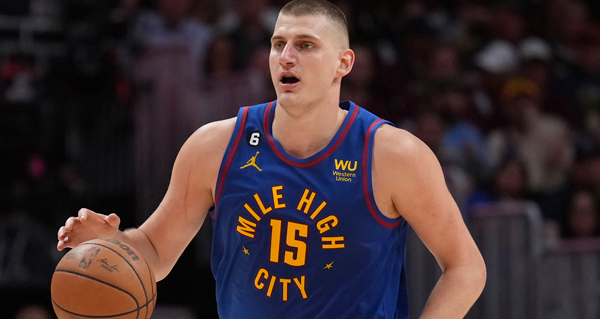The three most surprising teams of the 22-23 season have one thing in common and might have provided a glimpse of the future of the NBA.
Against most prognostications, the Denver Nuggets and Miami Heat made the NBA Finals, while the Sacramento Kings shot up the West standings. All three teams were built around playmaking centers that accentuated the strengths of their perimeter scorers and presented riddles that opposing defenses mostly failed to solve. The NBA tends to copy success, and the Nuggets, Heat and Kings could become the model.
The preeminent playmaking center is, obviously, Nikola Jokic. The two-time MVP dominated the playoffs and led Denver to its first-ever championship. He averaged 30 points, 13.5 rebounds and 9.5 assists. In the Finals, even Adebayo and the Heat could not find an answer for him. He diced up Miami’s zone, pummeled their defenders down low and, when all else failed, effortlessly tossed in shots from the perimeter. But what really unlocked the Nuggets and turned them into champions was how Jokic empowered his teammates. Jamal Murray scurried around Jokic screens, received dribble handoffs and averaged 26 points on 47% shooting in the playoffs.
With Jokic running the offense at the nail, defenses are forced to change their shape in a way that would be unrecognizable 20 years ago when centers grazed the paint and the low block. Opposing centers are dragged away from protecting the rim, forwards are forced to account for baseline cutters and smaller guards are often stuck defending bigger mismatches. The roles and responsibilities of every defender is morphed, and it’s difficult to adjust.
Here’s just one of many examples from Denver’s closeout Game 5 of the Finals. Jokic sets a screen for Bruce Brown and then flows into a pick-and-roll with Jeff Green. Jokic seamlessly goes from traditional screener to 7-foot ball-handler, and leads to all kinds of confused mismatches. Max Strus ends up on Jokic, forcing Adebayo to come with help. That leaves 6-foot Kyle Lowry as the rim protector. Jokic flips the ball to Green, who gets the easy layup.
The Kings have their lite version of this with Domantas Sabonis and De’Aaron Fox. In their first full season together, Sabonis and Fox led the Kings to 48 wins, 18 more than the season prior. New head coach Mike Brown spent six years as Steve Kerr’s lead assistant in Golden State and saw firsthand what the two-man game of Draymond Green and Stephen Curry could accomplish. He sought to emulate that with Sabonis and Fox, and the two quickly developed lethal pick-and-roll chemistry.
Sabonis averaged a career-high 7.3 assists, often finding Fox cutting to the basket off his high screens or handing the ball off to moving shooters like Kevin Heurter and Malik Monk. Here’s Sabonis in Sacramento’s first-round matchup against the Warriors. The Kings run a pistol action to get into their offense, with Fox pitching the ball ahead to Sabonis on the right wing. So much of Sacramento’s offense this season started this way, with Fox then screaming off a Sabonis screen and Sabonis finding him on his way to the basket. That’s what the Warriors expect here but, instead, Fox flares to his left and sets a screen for Huerter, who curls toward the basket. Jordan Poole chases his man, Huerter, and Kevon Looney responds by dropping back in coverage. This leaves just one defender up high to guard Sabonis and Fox. Fox comes back around to Sabonis, who hands the ball to Fox and screens Andrew Wiggins away from the shot.
Unlike Sacramento and Denver, Miami struggled to generate consistent offense for most of the season. Some of that is due to their reliance on role players making 3s. The TK play of their run to the 2020 Finals was Duncan Robinson and Tyler Herro scoring off dribble handoffs from Adebayo. There’s less of that in the Heat’s offense now, as Adebayo and Jimmy Butler have leaned more into isolation and shooters have gone cold for long stretches. But we’ve also seen Adebayo evolve as a playmaker, relying less on the set DHO action and getting more freedom to read the floor.
Some of Miami’s best offense happens after Adebayo grabs a defensive rebound and pushes the break, with shooters and cutters running into space.
In the Finals, one of Miami's pet actions was Adebayo at the nail with teammates running split cuts to his left. The Heat got two crucial buckets out of this in the fourth quarter of their Game 2 win. In the closeout Game 5, they went back to it to get Butler an easy basket when he’d been struggling. Like in the previous examples, Adebayo running an inverted offense leads to confused mismatches for the defense and easy buckets for the offense.
Of course, this wasn’t enough for the Heat to outduel the champion Nuggets. Miami was missing what Denver had in terms of talent and scoring around their star center (an issue, according to reports, that they may be trying to fix this offseason).
By virtue of the Nuggets winning the Finals, the rest of the NBA will be forced to respond. Jokic and his disciples are changing the way offense is played and putting even more strains on defenses across the league.
Teams like the Heat and Kings are already on their way. We’ve seen flashes of this in Minnesota with Karl-Anthony Towns, in Houston with Alperen Sangun and even in Philadelphia with Joel Embiid. Victor Wembanyama, the generational prospect who will be selected by the Spurs with the No. 1 pick next Thursday, is averaging nearly 2 ½ assists as a center in France.
A 7-footer who can see over the defense is as close to a quarterback in the NBA as it gets. If teams can surround their playmaking centers with scoring threats and enough good defenders, perhaps they, like the Nuggets, can march their way to a title.



